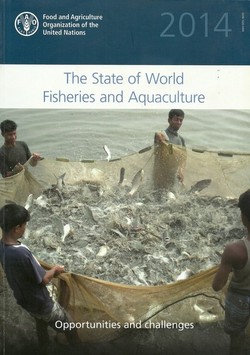
The State of World Fisheries and Aquaculture 2014
Opportunities and Challenges
Food and Agriculture Organization of the United Nation
Rome, 2014
Foreword
In a world where more than 800 million continue to suffer from chronic malnourishment and where the global population is expected to grow by another 2 billion to reach 9.6 billion people by 2050 – with a concentration in coastal urban areas - we must meet the huge challenge of feeding our planet while safeguarding its natural resources for future generations.
This new edition of The State of World Fisheries and Aquaculture highlights the significant role that fisheries and aquaculture plays in eliminating hunger, promoting health and reducing poverty. Never before have people consumed so much fish or depended so greatly on the sector for their well-being. Fish is extremely nutritious - a vital source of protein and essential nutrients, especially for many poorer members of our global community.
Fisheries and aquaculture is a source not just of health but also of wealth. Employment in the sector has grown faster than the world’s population. The sector provides jobs to tens of millions and supports the livelihoods of hundreds of millions. Fish continues to be one of the most-traded food commodities worldwide. It is especially important for developing countries, sometimes worth half the total value of their traded commodities.
However, we need to look beyond the economics and ensure that environmental well-being is compatible with human well-being in order to make long-term sustainable prosperity a reality for all. To this end, promoting responsible and sustainable fisheries and aquaculture is central to our work and purpose. We recognize that the health of our planet as well as our own health and future food security all hinge on how we treat the blue world. To provide wider ecosystem stewardship and improved governance of the sector, FAO is advancing Blue Growth as a coherent framework for the sustainable and socio- economic management of our aquatic resources. Anchored in the principles set out in the benchmark Code of Conduct for Responsible Fisheries back in 1995, Blue Growth focuses on capture fisheries, aquaculture, ecosystem services, trade and social protection. In line with FAO’s Reviewed Strategic Framework, the initiative focuses on promoting the sustainable use and conservation of aquatic renewable resources in an economically, socially and environmentally responsible manner. It aims at reconciling and balancing priorities between growth and conservation, and between industrial and artisanal fisheries and aquaculture, ensuring equitable benefits for communities. To reach these goals, the Blue Growth initiative taps into technical expertise throughout the Organization.
FAO recognizes the important contribution that small-scale fisheries make to global poverty alleviation and food security. To strengthen their often vulnerable and marginalized communities, FAO has been actively supporting the development of the Voluntary Guidelines for Securing Sustainable Small - scale Fisheries and working with Governments and non-state actors to assist countries in the implementation of the Voluntary Guidelines on the Responsible Governance of Tenure of Land, Fisheries and Forests. These efforts are also very much aligned with the 2014 International Year of Family Farming, during which we will continue to highlight the importance of aquaculture – especially small- scale fish farming - and support its development.
Global fish production continues to outpace world population growth, and aquaculture remains one of the fastest-growing food producing sectors. In 2012, aquaculture set another all-time production high and now provides almost half of all fish for human food. This share is projected to rise to 62 percent by 2030 as catches from wild capture fisheries level off and demand from an emerging global middle class substantially increases. If responsibly developed and practiced, aquaculture can generate lasting benefits for global food security and economic growth.
The fisheries and aquaculture sector is facing major challenges. These range from the scourge of illegal, unreported and unregulated (IUU) fishing to harmful fishing practices to wastage to poor governance. They can all be overcome with greater political will, strategic partnerships and fuller engagement with civil society and the private sector. We need to foster good governance by ensuring the uptake and application of international instruments such as the Port State Measures Agreement, and we need to spur innovative solutions with business and industry. We all have a role to play in order to enable fisheries and aquaculture to thrive responsibly and sustainably for present and future generations.
Contents
Foreword
Acknowledgements
Abbreviations and acronyms
Part 1: World Review of Fisheries and Aquaculture
Part 2: Selected Issues in Fisheries and Aquaculture
Part 3: Highlights of Special Studies
Part 4: Outlook
Prep. / Ayman Ashry
Manage. / Zeinab Osman



ساحة النقاش